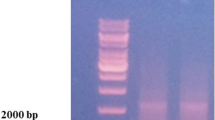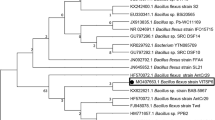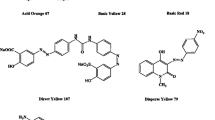Abstract
Lysinibacillus sp. RGS degrades sulfonated azo dye Reactive Orange 16 (RO16) efficiently. Superoxide dismutase and catalase activity were tested to study the response of Lysinibacillus sp. RGS to the oxidative stress generated by RO16. The results demonstrated that oxidative stress enzymes not only protect the cell from oxidative stress but also has a probable role in decolorization along with an involvement of oxidoreductive enzymes. Formation of three different metabolites after degradation of RO16 has been confirmed by GC-MS analysis. FTIR analysis verified the degradation of functional groups of RO16, and HPTLC confirmed the removal of auxochrome group from the RO16 after degradation. Toxicity studies confirmed the genotoxic, cytotoxic, and phytotoxic nature of RO16 and the formation of less toxic products after the treatment of Lysinibacillus sp. RGS. Therefore, Lysinibacillus sp. RGS has a better perspective of bioremediation for textile wastewater treatment.





Similar content being viewed by others
References
Achary MM, Panda BB (2009) Aluminum-induced DNA damage and adaptive response to genotoxic stress in plant cells are mediated through reactive oxygen intermediates. Mutation 25:201–209
Alinsafi A, Da Motta M, Le Bonte S, Pons MN, Benhammou A (2006) Effect of variability on the treatment of textile dyeing wastewater by activated sludge. Dyes Pigments 69:31–39
APHA, American Public Health Association (1998) Standard method for the examination of water and wastewater, vol method 2120 E, 20th edn. APHA–AWWA–WEF, Washington, DC
Carita R, Marin-Morales MA (2008) Induction of chromosome aberrations in the Allium cepa test system caused by the exposure of seeds to industrial effluents contaminated with azo dyes. Chemosphere 72:722–725
Chacko JT, Subramaniam K (2011) Enzymatic degradation of azo dyes—a review. Int J Environ Sci 1:1250–1260
Chakraborty R, Mukherjee AK, Mukherjee A (2009) Evaluation of genotoxicity of coal fly ash in root cells by combining comet assay with the Allium test. Environ Monit Asses 153:351–357
Frederick JR, Elkins GJ, Bollinger N, Hassett DJ, McDermott TR (2001) Factors affecting CAT expression in Pseudomonas aeruginosa biofilms and plank-tonic cells. Appl Environ Microbiol 67:1375–1379
Geckil H, Gencer S, Kahraman S, Erenler SO (2003) Genetic engineering of Enterobacter aerogenes with the Vitreoscilla hemoglobin gene: cell growth, survival, and antioxidant enzyme status under oxidative stress. Res Microbiol 154:425–431
Hao OJ, Kim H, Chiang PC (2000) Decolorization of wastewater. Crit Rev in Env Sci Technol 30:449–505
Hatvani N, Mecs I (2001) Production of laccase and manganese peroxidase by Lentinus edodes on malt containing by product of the brewing process. Process Biochem 37:491–496
Jadhav UU, Dawkar VV, Ghodake GS, Govindwar SP (2008) Biodegradation of direct red 5B, a textile dye by newly isolated Comomonas sp. UVS J Hazard Mater 158:507–516
Jadhav UU, Dawkar VV, Tamboli DP, Govindwar SP (2009) Purification and characterization of veratryl alcohol oxidase from Comomonas sp. UVS and its role in decolorization of textile dyes. Biotechnol Bioprocess Eng 14:369–376
Joshi SM, Inamdar SA, Telke AA, Tamboli DP, Govindwar SP (2010) Exploring the potential of natural bacterial consortium to degrade mixture of dyes and textile effluent. Inter Biodeter Biodegrad 64:622–628
Joshi SM, Inamdar SA, Jadhav JP, Govindwar SP (2013) Random UV mutagenesis approach for enhanced biodegradation of sulfonated azo dye, Green HE4B. Appl Biochem Biotechnol 169:1467–1481
Kadam AA, Telke AA, Jagtap SS, Govindwar SP (2011) Decolorization of adsorbed textile dyes by developed consortium of Pseudomonas sp. SUK1 and Aspergillus ochraceus NCIM-1146 under solid state fermentation. J Hazard Mater 189:486–494
Kalyani DC, Telke AA, Dhanve R, Jadhav JP (2009) Ecofriendly biodegradation and detoxification of Reactive Red 2 textile dye by newly isolated Pseudomonas sp. SUK1. J Hazard Mater 163:735–742
Karigar CS, Rao SS (2011) Role of microbial enzymes in the bioremediation of pollutants: a review. Enzym Res. doi:10.4061/2011/805187
Kurade MB, Waghmode TR, Tamboli DP, Govindwar SP (2012) Differential catalytic action of Brevibacillus laterosporus on two dissimilar azo dyes Remazol red and Rubine GFL. J Basic Microbiol 52:1–12
Lade HS, Waghmode TR, Kadam AA, Govindwar SP (2012) Enhanced biodegradation and detoxification of disperse azo dye Rubine GFL and textile industry effluent by defined fungal-bacterial consortium. Inter Biodeter Biodegrad 72:94–107
Laxminarayana E, Chary M, Kumar M, Charya M (2010) Decolourisation and biodegradation of sulphonated azo dyes by fungi to clean dye contaminated soil environments. J Nat Environ Sci 1:35–42
Lucas MS, Peres JA (2007) Degradation of Reactive Black 5 by Fenton/UV-C and ferrioxalate/H2O2/solar light processes. Dyes Pigments 74:622–629
McMullan G, Meehan C, Conneely A, Kirby N, Robinson T, Nigam P, Banat IM, Marchant R, Smyth WF (2001) Microbial decolorization and degradation of textile dyes. Appl Microbiol Biotechnol 56:81–87
Patil AV, Jadhav JP (2013) Evaluation of phytoremediation potential of Tagetes patula L. for the degradation of textile dye Reactive Blue 160 and assessment of the toxicity of degraded metabolites by cytogenotoxicity. Chemosphere 92:225–232
Paul J, Kadam AA, Govindwar SP, Kumar P, Varshney L (2013) An insight into the influence of low dose irradiation pretreatment on the microbial decolorization and degradation of Reactive Red-120 dye. Chemosphere 90:1348–1358
Pérez PD, Pablo IN, Chavarría M, de Lorenzo V (2013) Endogenous stress caused by faulty oxidation reactions fosters evolution of 2, 4-dinitrotoluene-degrading bacteria. PLoS Genet 9(8):e1003764
Phugare SS, Kalyani DC, Patil AV, Jadhav JP (2011) Textile dye degradation by bacterial consortium and subsequent toxicological analysis of dye and dye metabolites using cytotoxicity, genotoxicity and oxidative stress studies. J Hazard Mater 186:713–723
Pinheiro HM, Touraud E, Thomas O (2004) Aromatic amines from azo dye reduction: status review with emphasis on direct UV spectrophotometric detection in textile industry wastewaters. Dyes Pigments 61:121–139
Saratale G, Kalme S, Bhosale S, Govindwar S (2007) Biodegradation of kerosene in Aspergillus ochraceus (NCIM-1146). J Basic Microbiol 47:400–405
Saratale RG, Saratale GD, Chang JS, Govindwar SP (2009) Ecofriendly decolorization and degradation of Reactive Green 19A using Micrococcus glut amicus NCIM-2168. Bioresour Technol 100:3897–3905
Saratale RG, Gandhi SS, Purankar MV, Kurade MB, Govindwar SP, Sang Eun O, Saratale GD (2012) Decolorization and detoxification of sulfonated azo dye C.I. Remazol Red and textile effluent by isolated Lysinibacillus sp. RGS. J Biosci Bioeng 115:658–667
Sharma S, Sharma S, Singh PK, Swami RC, Sharma KP (2009) Exploring fish bioassay of textile dye wastewaters and their selected constituents in terms of mortality and erythrocyte disorders. Bull Environ Contam Toxicol 83:29–34
Supaka N, Juntongjin K, Damronglerd S, Delia ML, Strehaiano P (2004) Microbial decolorization of reactive azo dyes in a sequential anaerobic-aerobic system. J Chem Eng 99:169–176
Vandevivere PC, Bianchi R, Verstraere W (1998) Treatment and reuse of wastewater from the textile wet-processing industry: review of emerging technologies. J Chem Technol Biotechnol 72:289–302
Waghmode TR, Kurade MB, Khandare RV, Govindwar SP (2011) A sequential aerobic/microaerophilic decolorization of sulfonated mono azo dye Golden Yellow HER by microbial consortium GG-BL. Int Biodeter Biodegrad 65:1024–1034
Zhang Y, Meng D, Wang Z, Guo H, Wang Y, Wang X, Dong X (2012) Oxidative stress response in atrazine-degrading bacteria exposed to atrazine. J Hazard Mater 229:434–438
Acknowledgments
Priyanka A. Bedekar would like to thank University Grants Commission (UGC), New Delhi for providing UGC-JRF fellowship under UGC’s Major Research project.
Author information
Authors and Affiliations
Corresponding author
Additional information
Responsible editor: Robert Duran
Electronic supplementary material
Below is the link to the electronic supplementary material.
ESM 1
(DOC 34 kb)
Rights and permissions
About this article
Cite this article
Bedekar, P.A., Saratale, R.G., Saratale, G.D. et al. Oxidative stress response in dye degrading bacterium Lysinibacillus sp. RGS exposed to Reactive Orange 16, degradation of RO16 and evaluation of toxicity. Environ Sci Pollut Res 21, 11075–11085 (2014). https://doi.org/10.1007/s11356-014-3041-2
Received:
Accepted:
Published:
Issue Date:
DOI: https://doi.org/10.1007/s11356-014-3041-2




